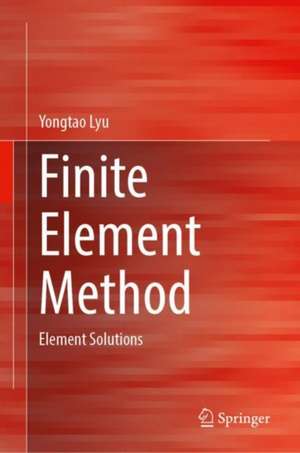Finite Element Method: Element Solutions
Autor Yongtao Lyuen Limba Engleză Hardback – 23 aug 2022
| Toate formatele și edițiile | Preț | Express |
|---|---|---|
| Paperback (1) | 379.70 lei 38-44 zile | |
| Springer Nature Singapore – 24 aug 2023 | 379.70 lei 38-44 zile | |
| Hardback (1) | 649.28 lei 3-5 săpt. | |
| Springer Nature Singapore – 23 aug 2022 | 649.28 lei 3-5 săpt. |
Preț: 649.28 lei
Preț vechi: 811.60 lei
-20% Nou
Puncte Express: 974
Preț estimativ în valută:
124.28€ • 135.04$ • 104.46£
124.28€ • 135.04$ • 104.46£
Carte disponibilă
Livrare economică 31 martie-14 aprilie
Preluare comenzi: 021 569.72.76
Specificații
ISBN-13: 9789811933622
ISBN-10: 9811933626
Pagini: 194
Ilustrații: XXIII, 194 p. 84 illus., 28 illus. in color.
Dimensiuni: 155 x 235 mm
Greutate: 0.52 kg
Ediția:1st ed. 2022
Editura: Springer Nature Singapore
Colecția Springer
Locul publicării:Singapore, Singapore
ISBN-10: 9811933626
Pagini: 194
Ilustrații: XXIII, 194 p. 84 illus., 28 illus. in color.
Dimensiuni: 155 x 235 mm
Greutate: 0.52 kg
Ediția:1st ed. 2022
Editura: Springer Nature Singapore
Colecția Springer
Locul publicării:Singapore, Singapore
Cuprins
Chapter 1 Introduction.- Chapter 2 Theoretical basis of the finite element method.- Chapter 3 Finite element analysis using bar element.- Chapter 4 Finite element analysis using beam element.- Chapter 5 Finite element analysis using triangular element.- Chapter 6 Finite element analysis using rectangular element.- Chapter 7 Finite element analysis using 3D elements.- Chapter 8 High order Lagrange element.
Notă biografică
Yongtao Lyu is currently an associate professor at the Department of Engineering Mechanics, Dalian University of Technology, China. He obtained his bachelor and master of engineering degrees (2001-2007) from Huazhong University of Science and Technology (nationally TOP 10), China. Then he received the EPSRC scholarship and completed his Ph.D. study (2007-2010) at Cardiff University, UK. Afterwards, he worked as a postdoctoral researcher (2010-2013) at the Institute of Biomechanics, Hamburg University of Technology, Germany, and then as a senior research associate (2013-2015) at the Institute for in silico Medicine, the University of Sheffield, UK. Dr. Lyu’s main research interests lie primarily in the mechanical behavior of biomaterials, the computational modelling of human body systems, the bionic design of bone scaffolds. Dr. Lyu has published over 40 SCI-indexed academic papers. Most of them are in the top-level journals in the field of biomechanics, such as the Journal of Biomechanics, Journal of the Mechanical Behavior of Biomedical Materials, etc. Additionally, he has published several academic book chapters.
Textul de pe ultima copertă
This textbook is intended to be used by the senior engineering undergraduate and the graduate student. Nowadays, the finite element method has become one of the most widely used techniques in all the engineering fields, including aerospace engineering, mechanical engineering, biomedical engineering, etc. To unveil the FE technique, the textbook provides a detailed description of the finite element method, starting from the most important basic theoretical basis, e.g., the Galerkin method, the variational principle, followed by the detailed description of the various types of finite elements, including the bar, the beam, the triangular, the rectangular, the 3D elements. The primary aim of the textbook is to provide a comprehensive description of the FE solutions using different types of elements. Therefore, the properties of different elements and the solution discrepancies caused by using different elements are highlighted in the book. Thus, the textbook is very helpful for engineers to understand the behaviours of different types of elements. Additionally, the textbook can help the students and engineers write FE codes based on the theories presented in the book. Furthermore, the textbook can serve as the basis for some advanced computational mechanics courses, such as the nonlinear finite element method.
Caracteristici
Includes in-depth discussions on the properties of different finite elements Covers the important knowledge related to the finite element programming Provides a detailed description of the finite element solution procedures using different types of elements
